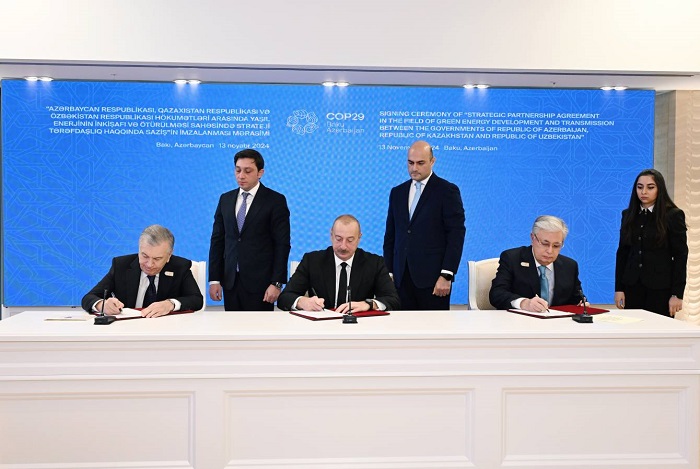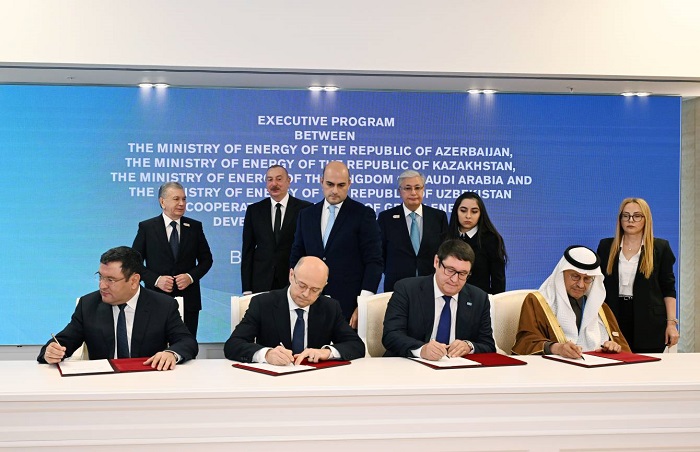At the COP 29 World Climate Summit, the heads of Kazakhstan, Azerbaijan and Uzbekistan signed an agreement on strategic partnership in the field of green energy production and transmission.
“The document opens up new opportunities for the integration of the energy systems of our states, as well as the creation of reliable corridors for the supply of environmentally friendly energy to European and other markets,” President of Kazakhstan Kassym-Jomart Tokayev said at the signing ceremony.
Tokayev noted that the practical results of this agreement will contribute to the development of the Middle Corridor as a “green bridge” connecting the economies of the three nations.
For Kazakhstan, striving for carbon neutrality, “green” energy is a priority. The country is actively working to reduce dependence on fossil resources, develop technological innovations and create an infrastructure capable of maintaining environmental sustainability. Kazakhstan has already reached agreements with foreign partners on the implementation of “green” projects with a total capacity of 43 GW.
President Ilham Aliyev of Azerbaijan stressed that the new agreement brings fraternal relations and strategic partnership between the three countries to a new level. “In essence, integration processes, processes related to transport, energy, trade in the regions of Central Asia and the Caucasus, today allow us to say that these two regions act synchronously in many issues, including in the field of green energy development,” he said.
President Shavkat Mirziyoyev of Uzbekistan emphasized that renewable energy isn’t merely an economic objective but a commitment to the future and a responsibility towards generations to come.
Uzbekistan has implemented a comprehensive program to accelerate the development of green energy, with an annual target of adding approximately two gigawatts of solar and wind power generation capacity. The nation aims to increase the share of renewable energy sources to 40% by 2030.
Mirziyoyev expressed optimism about the project’s economic benefits for all stakeholders. He highlighted the potential for creating tens of thousands of jobs, enhancing energy infrastructure, and fostering technological and business collaborations.
In the presence of the heads of state, the energy ministers of Kazakhstan, Azerbaijan, Uzbekistan and Saudi Arabia signed an Executive Program on cooperation in the field of development and transfer of green energy.
Uzbekistan plans to export excess electricity to Europe via a corridor through Kazakhstan and Azerbaijan
Uzbekistan aims to become a significant exporter of electricity to Europe by 2030, leveraging its surplus power generation capacity. Deputy Energy Minister Umid Mamadaminov, in an interview with the Uzbek agency Spot, said that by 2030 the country will be able to export from 10 to 15 billion kWh of electricity.
This plan hinges on the development of crucial infrastructure to facilitate electricity transmission to Europe through a corridor traversing Kazakhstan and Azerbaijan.
By 2030, Uzbekistan’s domestic electricity demand is projected to reach approximately 120-125 billion kWh. Given the nation’s generating capacity of around 135 billion kWh, a substantial surplus will be available for export.
“As soon as the infrastructure is ready, electricity can be exported to Europe,” said the deputy energy minister.
A key project enabling Uzbekistan’s electricity export plans involves the construction of an undersea cable across the Black Sea. This cable will link the power grids of Uzbekistan, Kazakhstan, and Azerbaijan directly to Europe. As Energy Minister Zhurabek Mirzamakhmudov said in August, the volume of electricity exported through this cable will depend on the cable’s capacity and European demand.
This undersea cable project is a collaborative effort between Uzbekistan, Kazakhstan, and Azerbaijan. The three nations have already approved the terms of reference for a preliminary feasibility study. Italian energy company CESI has been tasked with conducting this study.
It is expected that the preparation of the feasibility study will take about one and a half years and will be completed by the end of 2025.
After that, the construction of 2,500-km long cable will start. The cable will use HVDC technology (high-voltage direct current line), which will ensure efficient transmission of energy over long distances. The cost of the project is estimated at more than $ 2 billion.
The price of electricity exported to Europe will be determined by the market conditions. According to Mamadaminov, the minimum price will be 4-5 cents per kilowatt. ///nCa, 14 November 2024

